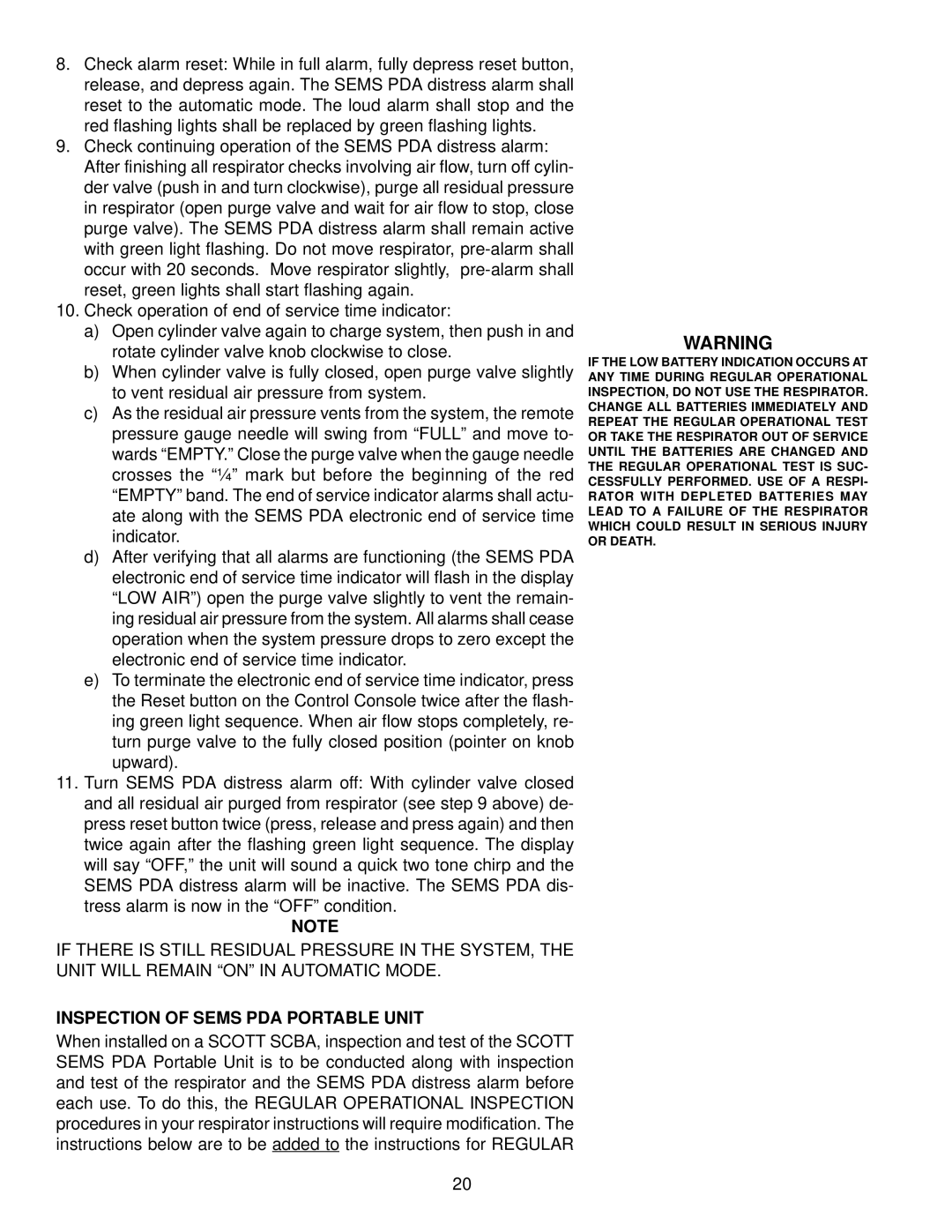8.Check alarm reset: While in full alarm, fully depress reset button, release, and depress again. The SEMS PDA distress alarm shall reset to the automatic mode. The loud alarm shall stop and the red flashing lights shall be replaced by green flashing lights.
9.Check continuing operation of the SEMS PDA distress alarm: After finishing all respirator checks involving air flow, turn off cylin- der valve (push in and turn clockwise), purge all residual pressure in respirator (open purge valve and wait for air flow to stop, close purge valve). The SEMS PDA distress alarm shall remain active with green light flashing. Do not move respirator,
10.Check operation of end of service time indicator:
a)Open cylinder valve again to charge system, then push in and rotate cylinder valve knob clockwise to close.
b)When cylinder valve is fully closed, open purge valve slightly to vent residual air pressure from system.
c)As the residual air pressure vents from the system, the remote pressure gauge needle will swing from “FULL” and move to- wards “EMPTY.” Close the purge valve when the gauge needle crosses the “¼” mark but before the beginning of the red “EMPTY” band. The end of service indicator alarms shall actu- ate along with the SEMS PDA electronic end of service time indicator.
d)After verifying that all alarms are functioning (the SEMS PDA electronic end of service time indicator will flash in the display “LOW AIR”) open the purge valve slightly to vent the remain- ing residual air pressure from the system. All alarms shall cease operation when the system pressure drops to zero except the electronic end of service time indicator.
e)To terminate the electronic end of service time indicator, press the Reset button on the Control Console twice after the flash- ing green light sequence. When air flow stops completely, re- turn purge valve to the fully closed position (pointer on knob upward).
11.Turn SEMS PDA distress alarm off: With cylinder valve closed and all residual air purged from respirator (see step 9 above) de- press reset button twice (press, release and press again) and then
twice again after the flashing green light sequence. The display will say “OFF,” the unit will sound a quick two tone chirp and the SEMS PDA distress alarm will be inactive. The SEMS PDA dis- tress alarm is now in the “OFF” condition.
NOTE
IF THERE IS STILL RESIDUAL PRESSURE IN THE SYSTEM, THE UNIT WILL REMAIN “ON” IN AUTOMATIC MODE.
WARNING
IF THE LOW BATTERY INDICATION OCCURS AT ANY TIME DURING REGULAR OPERATIONAL INSPECTION, DO NOT USE THE RESPIRATOR. CHANGE ALL BATTERIES IMMEDIATELY AND REPEAT THE REGULAR OPERATIONAL TEST OR TAKE THE RESPIRATOR OUT OF SERVICE UNTIL THE BATTERIES ARE CHANGED AND THE REGULAR OPERATIONAL TEST IS SUC- CESSFULLY PERFORMED. USE OF A RESPI- RATOR WITH DEPLETED BATTERIES MAY LEAD TO A FAILURE OF THE RESPIRATOR WHICH COULD RESULT IN SERIOUS INJURY OR DEATH.
INSPECTION OF SEMS PDA PORTABLE UNIT
When installed on a SCOTT SCBA, inspection and test of the SCOTT SEMS PDA Portable Unit is to be conducted along with inspection and test of the respirator and the SEMS PDA distress alarm before each use. To do this, the REGULAR OPERATIONAL INSPECTION procedures in your respirator instructions will require modification. The instructions below are to be added to the instructions for REGULAR
20
